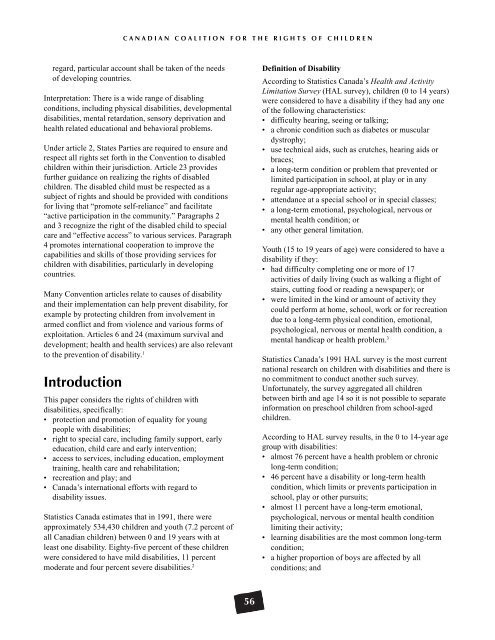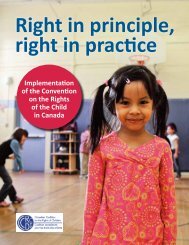Poste - Canadian Coalition for the Rights of Children
Poste - Canadian Coalition for the Rights of Children
Poste - Canadian Coalition for the Rights of Children
Create successful ePaper yourself
Turn your PDF publications into a flip-book with our unique Google optimized e-Paper software.
C A N A D I A N C O A L I T I O N F O R T H E R I G H T S O F C H I L D R E N<br />
regard, particular account shall be taken <strong>of</strong> <strong>the</strong> needs<br />
<strong>of</strong> developing countries.<br />
Interpretation: There is a wide range <strong>of</strong> disabling<br />
conditions, including physical disabilities, developmental<br />
disabilities, mental retardation, sensory deprivation and<br />
health related educational and behavioral problems.<br />
Under article 2, States Parties are required to ensure and<br />
respect all rights set <strong>for</strong>th in <strong>the</strong> Convention to disabled<br />
children within <strong>the</strong>ir jurisdiction. Article 23 provides<br />
fur<strong>the</strong>r guidance on realizing <strong>the</strong> rights <strong>of</strong> disabled<br />
children. The disabled child must be respected as a<br />
subject <strong>of</strong> rights and should be provided with conditions<br />
<strong>for</strong> living that “promote self-reliance” and facilitate<br />
“active participation in <strong>the</strong> community.” Paragraphs 2<br />
and 3 recognize <strong>the</strong> right <strong>of</strong> <strong>the</strong> disabled child to special<br />
care and “effective access” to various services. Paragraph<br />
4 promotes international cooperation to improve <strong>the</strong><br />
capabilities and skills <strong>of</strong> those providing services <strong>for</strong><br />
children with disabilities, particularly in developing<br />
countries.<br />
Many Convention articles relate to causes <strong>of</strong> disability<br />
and <strong>the</strong>ir implementation can help prevent disability, <strong>for</strong><br />
example by protecting children from involvement in<br />
armed conflict and from violence and various <strong>for</strong>ms <strong>of</strong><br />
exploitation. Articles 6 and 24 (maximum survival and<br />
development; health and health services) are also relevant<br />
to <strong>the</strong> prevention <strong>of</strong> disability. 1<br />
Introduction<br />
This paper considers <strong>the</strong> rights <strong>of</strong> children with<br />
disabilities, specifically:<br />
• protection and promotion <strong>of</strong> equality <strong>for</strong> young<br />
people with disabilities;<br />
• right to special care, including family support, early<br />
education, child care and early intervention;<br />
• access to services, including education, employment<br />
training, health care and rehabilitation;<br />
• recreation and play; and<br />
• Canada’s international ef<strong>for</strong>ts with regard to<br />
disability issues.<br />
Statistics Canada estimates that in 1991, <strong>the</strong>re were<br />
approximately 534,430 children and youth (7.2 percent <strong>of</strong><br />
all <strong>Canadian</strong> children) between 0 and 19 years with at<br />
least one disability. Eighty-five percent <strong>of</strong> <strong>the</strong>se children<br />
were considered to have mild disabilities, 11 percent<br />
moderate and four percent severe disabilities. 2<br />
56<br />
Definition <strong>of</strong> Disability<br />
According to Statistics Canada’s Health and Activity<br />
Limitation Survey (HAL survey), children (0 to 14 years)<br />
were considered to have a disability if <strong>the</strong>y had any one<br />
<strong>of</strong> <strong>the</strong> following characteristics:<br />
• difficulty hearing, seeing or talking;<br />
• a chronic condition such as diabetes or muscular<br />
dystrophy;<br />
• use technical aids, such as crutches, hearing aids or<br />
braces;<br />
• a long-term condition or problem that prevented or<br />
limited participation in school, at play or in any<br />
regular age-appropriate activity;<br />
• attendance at a special school or in special classes;<br />
• a long-term emotional, psychological, nervous or<br />
mental health condition; or<br />
• any o<strong>the</strong>r general limitation.<br />
Youth (15 to 19 years <strong>of</strong> age) were considered to have a<br />
disability if <strong>the</strong>y:<br />
• had difficulty completing one or more <strong>of</strong> 17<br />
activities <strong>of</strong> daily living (such as walking a flight <strong>of</strong><br />
stairs, cutting food or reading a newspaper); or<br />
• were limited in <strong>the</strong> kind or amount <strong>of</strong> activity <strong>the</strong>y<br />
could per<strong>for</strong>m at home, school, work or <strong>for</strong> recreation<br />
due to a long-term physical condition, emotional,<br />
psychological, nervous or mental health condition, a<br />
mental handicap or health problem. 3<br />
Statistics Canada’s 1991 HAL survey is <strong>the</strong> most current<br />
national research on children with disabilities and <strong>the</strong>re is<br />
no commitment to conduct ano<strong>the</strong>r such survey.<br />
Un<strong>for</strong>tunately, <strong>the</strong> survey aggregated all children<br />
between birth and age 14 so it is not possible to separate<br />
in<strong>for</strong>mation on preschool children from school-aged<br />
children.<br />
According to HAL survey results, in <strong>the</strong> 0 to 14-year age<br />
group with disabilities:<br />
• almost 76 percent have a health problem or chronic<br />
long-term condition;<br />
• 46 percent have a disability or long-term health<br />
condition, which limits or prevents participation in<br />
school, play or o<strong>the</strong>r pursuits;<br />
• almost 11 percent have a long-term emotional,<br />
psychological, nervous or mental health condition<br />
limiting <strong>the</strong>ir activity;<br />
• learning disabilities are <strong>the</strong> most common long-term<br />
condition;<br />
• a higher proportion <strong>of</strong> boys are affected by all<br />
conditions; and




